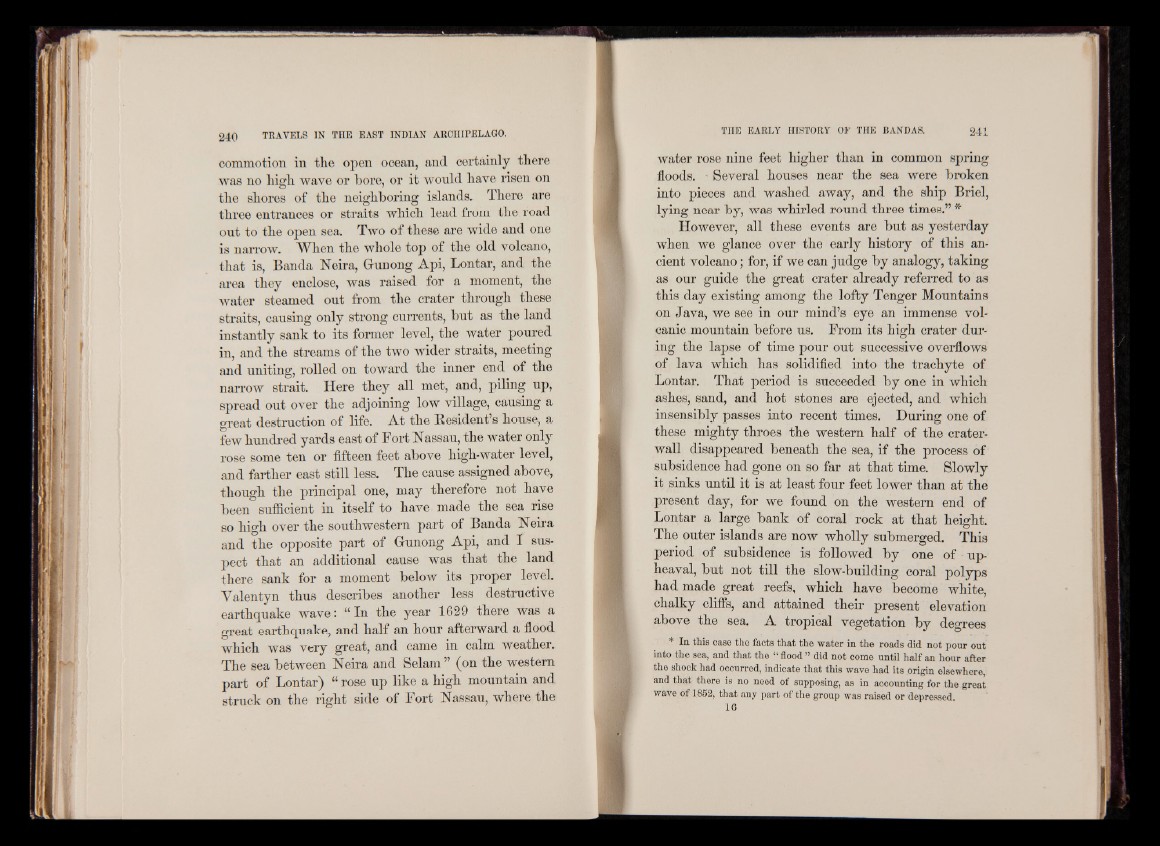
commotion in the open ocean, and certainly there
was no high wave or bore, or it would have risen on
the shores of the neighboring islands.. There are
three entrances or straits which lead from the road
out to the open sea. Two of these are wide and one
is narrow. WTien the whole top of the old volcano,
that is, Banda ISTeira, Gunong Api, Lontar, and the
area they enclose, was raised for a moment, the
water steamed out from the crater through these
straits, causing only strong currents, but as the land
instantly sank to its former level, the water poured
in, and the streams of the two wider straits, meeting
and uniting, rolled on toward the inner end of the
narrow strait. Here they all met, and, piling up,
spread out over the adjoining low village, causing a
great destruction of life. At the Resident’s house, a
few hundred yards east of Fort Nassau, the water only
rose some ten or fifteen feet above high-water level,
and farther east still less. The cause assigned above,
though the principal one, may therefore not have
been sufficient in itself to have made the sea rise
so high over the southwestern part of Banda Neira
and the opposite part of Gunong Api, and I suspect
that an additional cause was that the land
there sank for a moment below its proper level.
Valentyn thu3 describes another less destructive
earthquake wave: “ In the year 1629 there was a
great earthquake, and half an hour afterward a flood
which was very great, and came in calm weather.
The sea between Neira and Selam ” (on the western
part of Lontar) “ rose up like a high mountain and
struck on the right side of Fort Nassau, where the
water rose nine feet higher than in common spring
floods. Several houses near the sea were broken
into pieces and washed away, and the ship Briel,
lying near by, was whirled round three times.” *
However, all these events are but as yesterday
when we glance over the early history of this ancient
volcano; for, if we can judge by analogy, taking
as our guide the great crater already referred to as
this day existing among the lofty Tenger Mountains
on Java, we see in our mind’s eye an immense volcanic
mountain before us. From its high crater during
the lapse of time pour out successive overflows
of lava which has solidified into the trachyte of
Lontar. That period is succeeded by one in which
ashes, sand, and hot stones are ejected, and which
insensibly passes into recent times. During one of
these mighty throes the western half of the crater-
wall disappeared beneath the sea, if the process of
subsidence had gone on so far at that time. Slowly
it sinks until it is at least four feet lower than at the
present day, for we found on the western end of
Lontar a large bank of coral rock at that height.
The outer islands are now wholly submerged. This
period of subsidence is followed by one of upheaval,
but not till the slow-building coral polyps
had made great reefs, which have become white,
chalky cliffs, and attained their present elevation
above the sea. A tropical vegetation by degrees
* In tins case the facts that the water in the roads did not pour out
into the sea, and that the “ flood” did not come until half an hour after
the shock had occurred, indicate that this wave had its origin elsewhere
and that there is no need of supposing, as in accounting for the great
wave of 1852, that any part of the group was raised or depressed.
16